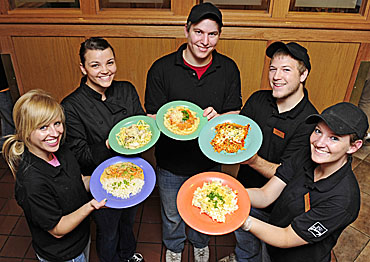AMES, Iowa -- While it's not uncommon for students to be serving other students at university dining halls, an introductory culinary science course (FSHN 104) at Iowa State University is now allowing students to also create new menu options for their fellow students through a partnership with ISU Dining.
Students enrolled in the "Intro. to Professional Skills in Culinary Science" course are required to become paid ISU Dining employees, where they work with the chefs and cooks in the kitchen for 100 hours of culinary skills work experience. In the process, they are asked to prepare and test a new recipe in the dining halls -- a project that is nearly two-thirds of their final grade.
After working with ISU Dining's chefs to develop their culinary creations, the students first prepare it and serve it to 20 students, collecting written feedback from those who sampled it. They then use that feedback to improve upon the recipe before preparing it again for 100 students.
Making the menu rotation
If the new dish is well-received and cost-effective to prepare in large quantities, it may be considered for ISU Dining's regular menu rotation. One of the recipes created by culinary science sophomore Rebecca Swegle last fall -- "Cyclone Pasta," which is spiral pasta served with a red sauce that contains red and yellow peppers and sausage -- is now in the rotation.
"One goal of this recipe project is to get ISU Dining some new recipes," said Erica Beirman, Iowa State's culinary science coordinator and a lecturer in food science and human nutrition. "And as I've discussed with the chefs, they get to approve these projects and we want them to approve projects that can be feasible and utilized in a dining center that prepares meals for 2,400 students each meal."
"We get recipes out of it [the class], and hopefully we also get continued employment with the culinary science students, since they come to us at a different level [of culinary interest] than most of our students," said ISU Dining's Executive Chef Everett Phillips. "The students from the class do more kitchen work and cooking with food in a large-scale operation [than some of the other student employees]. It's also nice for them to come up with these menu ideas too because their ideas are different from our ideas a lot of the time."
Students in this semester's class, taught by Beirman, have been testing their new dishes in both the Union Drive Marketplace and Season's dining centers.

Culinary science students and the entrees they prepared this week for diners in the Union Drive Marketplace (l-r): Ashley Swanson, rice with peanut cilantro sauce; Kendall Olson, Italian chicken pasta; Dan Nelson, pasta with spicy Ragu sauce; Curtis West, pizza casserole; and Courtney Van Arkel, rotini pasta dish. Photo by Bob Elbert, ISU News Service. (download print quality photo)
Adding soy to the menu
But it's not only students in the culinary science class who are creating new ISU Dining menu options. Cassie Miller and Amanda Pudlik, two culinary science juniors, also created new soy-based recipes in ISU's research food lab as interns for the Iowa Soy Foods Council last summer.
Phillips reports that some of their creations -- including Southwest Tofu Pasta [tofu and salsa macaroni and cheese,] soy pad Thai noodles and shrimp, and tofu croutons -- have been added to ISU Dining's rotation. And two new desserts -- a Hawaiian scone and blueberry crumble cake -- will be coming to campus dining locations soon.
"Some of the desserts we haven't quite perfected yet to produce in mass quantity," Phillips said. "The scones we will be using in Conversations [a new café/dining center in the Oak/Elm Residence Hall] when that opens. We're trying to make a base [soy-based] scone, and then change the flavors of them. We start by making them for 100 servings. And once we have that mastered, we can multiply that out for 1,500, which is what we normally make in each dining hall."
"The trick is getting them [the student soy recipes] standardized, because they're home-sized recipes and you just can't take something from the recipe section of the Sunday paper and scale it up," said Beirman. "You have to do some testing for yields and cost benefit."
Previously a manager for ISU Dining before accepting a faculty
position three years ago, Beirman sees the additional student
culinary input being a benefit to all parties -- including ISU
students who get to sample some new dishes in the dining
centers.
